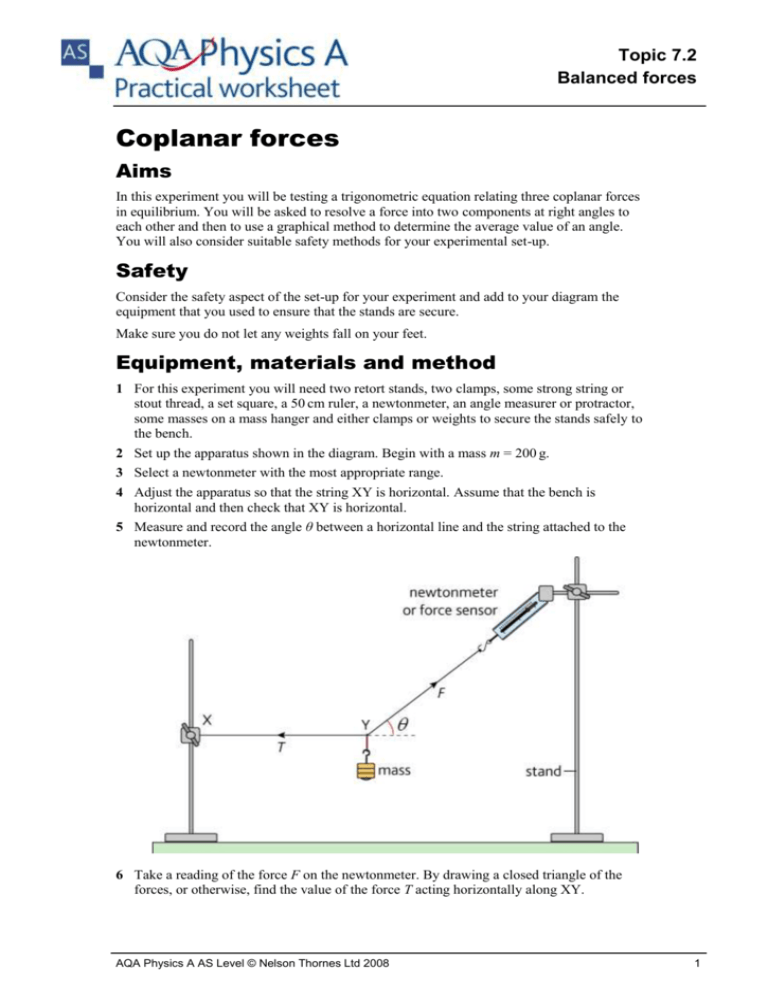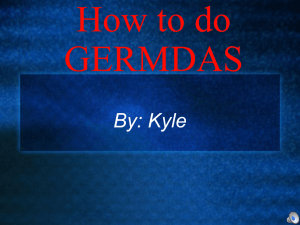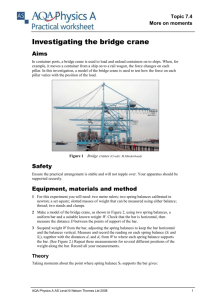AQA AS level Physics A
advertisement

Topic 7.2 Balanced forces Coplanar forces Aims In this experiment you will be testing a trigonometric equation relating three coplanar forces in equilibrium. You will be asked to resolve a force into two components at right angles to each other and then to use a graphical method to determine the average value of an angle. You will also consider suitable safety methods for your experimental set-up. Safety Consider the safety aspect of the set-up for your experiment and add to your diagram the equipment that you used to ensure that the stands are secure. Make sure you do not let any weights fall on your feet. Equipment, materials and method 1 For this experiment you will need two retort stands, two clamps, some strong string or stout thread, a set square, a 50 cm ruler, a newtonmeter, an angle measurer or protractor, some masses on a mass hanger and either clamps or weights to secure the stands safely to the bench. 2 Set up the apparatus shown in the diagram. Begin with a mass m = 200 g. 3 Select a newtonmeter with the most appropriate range. 4 Adjust the apparatus so that the string XY is horizontal. Assume that the bench is horizontal and then check that XY is horizontal. 5 Measure and record the angle θ between a horizontal line and the string attached to the newtonmeter. 6 Take a reading of the force F on the newtonmeter. By drawing a closed triangle of the forces, or otherwise, find the value of the force T acting horizontally along XY. AQA Physics A AS Level © Nelson Thornes Ltd 2008 1 Topic 7.2 Balanced forces 7 Repeat the experiment for several values of mass m and tabulate your measurements. Ensure that, for each mass, you adjust the set-up so that XY is horizontal. Question How did you ensure that XY was horizontal? You may add to the diagram above to explain your answer. Results Plot a graph of the weight mg on the y-axis against the force F on the x-axis. Discussion Consider the triangle you drew previously and determine the equation of the line of your graph. Hence show that the gradient of your graph is equal to sin θ. AQA Physics A AS Level © Nelson Thornes Ltd 2008 2 Topic 7.2 Balanced forces Teachers Notes Aims To investigate the vertical component of a force. To consider suitable methods of ensuring that stands are securely attached to the bench when applying forces to them. To use a graphical method to determine an average value of an angle. Safety The stands must be securely fixed to the bench by using either a G-clamp or a heavy mass (at least 3 kg). Bear in mind that the student may need to alter the position of one of the stands during the experiment in order to keep the string XY horizontal. Protect bench and feet from falling masses. Teaching notes 8 The level of XY can be adjusted either by moving the stands further apart (or closer), or by raising or lowering one of the clamps. 9 The practical part of this experiment will take 20–30 minutes. 10 A newtonmeter with the smallest scale that still allows the maximum readings to be taken will minimise the uncertainty when reading values. 11 Drawing a closed triangle of the forces, or resolving the forces into their components, shows that: sin θ = mg F 12 Common error: students forget to change the mass to weight for use in the calculation. 13 Note that the force T does not need to be calculated for each measurement in order to plot the graph. 14 The graph scale chosen should ensure that the majority of the graph paper is used. A triangle should be drawn to show the calculation of the gradient. The area of this triangle should be as large as possible (at least 60 cm2) to minimise error. 15 Students frequently attempt to find ‘accurate points’ on the graph from which to calculate the gradient. When working with a line of best fit, this is not an appropriate method. It is better practice to calculate the gradient using a triangle that is as large as possible. AQA Physics A AS Level © Nelson Thornes Ltd 2008 3 Topic 7.2 Balanced forces Answer to question 1 Ensure that XY is horizontal by taking a vertical measurement from the bench at points X and Y. Use a set square to ensure that the ruler is vertical. Discussion Drawing a closed triangle of the forces, or resolving the forces into their components, shows that mg = F sin θ. This is the equation of the graph (in the form y = mx + c), where sin θ is the gradient. AQA Physics A AS Level © Nelson Thornes Ltd 2008 4 Topic 7.2 Balanced forces Equipment and materials required Each student or pair of students will require the following equipment: about 2 m of strong string or stout thread two retort stands with clamps a set square 50 cm ruler a range of newtonmeters with different scales 6 100 g slotted masses on a 100 g mass hanger an angle measurer or protractor G-clamps to secure the stands safely (see comment below) graph paper Figure 1 Experimental set-up AQA Physics A AS Level © Nelson Thornes Ltd 2008 5 Topic 7.2 Balanced forces Figure 2 Ensuring XY is horizontal CLEAPSS information on spring balances: Laboratory Handbook/CD-ROM section 9.2.1. Safety The stands must be securely fixed to the bench by using either a G-clamp or a heavy mass (at least 3 kg). Bear in mind that the student may need to alter the position of one of the stands during the experiment in order to keep the string XY horizontal (see Figure 2). Use a bench protector and warn students to take care in case falling weights hit their feet. AQA Physics A AS Level © Nelson Thornes Ltd 2008 6







